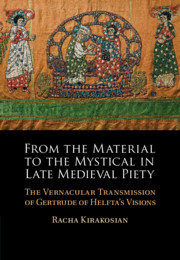 From the Material to the Mystical in Late Medieval Piety
From the Material to the Mystical in Late Medieval Piety Book contents
- From the Material to the Mystical in Late Medieval Piety
- From the Material to the Mystical in Late Medieval Piety
- Copyright page
- Dedication
- Contents
- Illustrations
- Acknowledgements
- Note on the Maps
- Introduction
- One The Helfta Scriptorium
- Two Redactions within a Dynamic Textuality
- Three Manuscript Transmission History
- Four The Book’s Self-Reflectivity
- Five The Scriptorial Heart
- Six Imaginary Textiles
- Final Remarks
- Book part
- Notes
- Bibliography
- Index
Introduction
Published online by Cambridge University Press: 01 September 2021
- From the Material to the Mystical in Late Medieval Piety
- From the Material to the Mystical in Late Medieval Piety
- Copyright page
- Dedication
- Contents
- Illustrations
- Acknowledgements
- Note on the Maps
- Introduction
- One The Helfta Scriptorium
- Two Redactions within a Dynamic Textuality
- Three Manuscript Transmission History
- Four The Book’s Self-Reflectivity
- Five The Scriptorial Heart
- Six Imaginary Textiles
- Final Remarks
- Book part
- Notes
- Bibliography
- Index
Summary
Visionary writing was popular with both women and men in the Middle Ages,1 and it has never ceased to attract the interest of scholars and believers alike. The German mystic Gertrude the Great of Helfta (ca. 1256–1301) is, to this day, globally venerated in the Catholic Church as a saint central to the Sacred Heart devotion. The earliest account of her life, the Legatus divinae pietatis (Legatus for short), partly written by herself, deals primarily with her revelations, prayers, and teachings; it is one of several mystical and hagiographic texts originating from the Saxon convent of Helfta. Written around 1300, it gives an account of a visionary culture practised by liturgically orientated and exegetically sophisticated religious women living in monastic communities.2 The history of its reception serves as a mirror – in the medieval sense of an ‘example’ – to the development of devotional culture. This study looks at the emergence and reception of the German redactions of the Legatus, illuminating the text material from a variety of angles, including historical, codicological, and literary aspects. The chronological focus of this book is the late thirteenth to fifteenth centuries, a period marked by a revival of mystical devotion, monastic reform, and – significantly, for the purpose of this study – an intense increase in pious book production. With this study, I hope to raise awareness of the late medieval resonances the Legatus had in vernacular contexts and to show its broader implications for our understanding of late medieval rewritings of Latin material more generally. My driving questions, from which a number of other questions follows, are: how was the Legatus read in late medieval vernacular contexts, and what do these readings tell us about how collaborative aspects of medieval text production as processes of translation, abbreviation, and redaction emerged from within a culture of hagiographic and mystical rewriting?
- Type
- Chapter
- Information
- From the Material to the Mystical in Late Medieval PietyThe Vernacular Transmission of Gertrude of Helfta's Visions, pp. 1 - 11Publisher: Cambridge University PressPrint publication year: 2021
